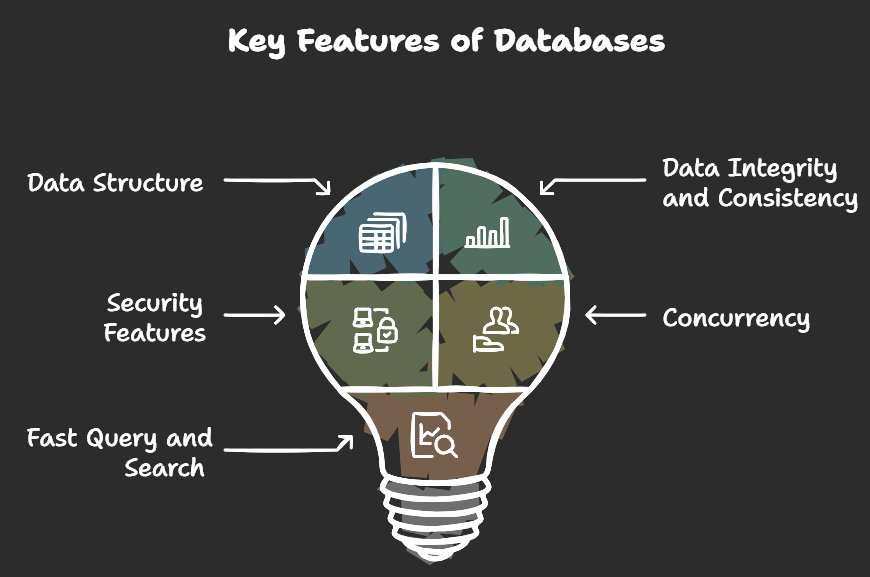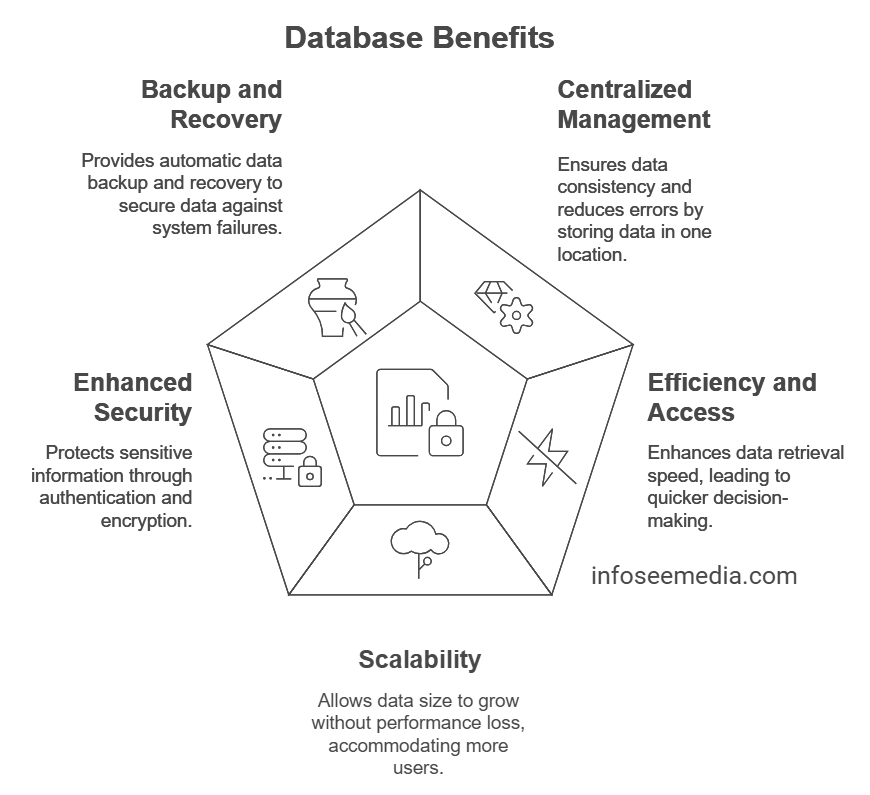Have you ever wondered what happens behind the scenes, where all information for your favorite app, shopping website, or even social media exists? Well, behind these silent doors, there exist databases quietly organizing, storing, and retrieving data every time needed. Databases form the backbone of our digital world and are used across almost all sectors, be it finance, healthcare, education, or entertainment.
What is a Database?
A database isn’t a dumping ground for information. Rather, it’s an organized structure designed to manage data in the best way possible. Think of it as an over-organized digital library, allowing for storing lots of information with easy access, editing, and analysis. Whether streaming music, ordering a meal online, or checking your bank balance, there is a database working in the background.
Introduction to Databases
Now in this guide, we would deep dive into the databases—from learning about what they are to know the different types and types involved within those, all the reasons of why databases are needed to be able to take appreciation for silent workhorse, which gives a support mechanism for the data that brings your world together.
Basic Understanding of Databases
Basic Knowledge of Databases
Basically, it is a structured collection of data that we use to store, retrieve, and manage information efficiently. Try to imagine a spreadsheet where the cells are filled with one particular value and each row and column contains related data-about this is a simple database, and the databases go ahead and beyond just organizing data-also they help us search and apply it when the time is needed without resorting to endless rows, doing all the work of hand sorting.
How Databases Work
Databases work on the structuring of data in such a way that it becomes easier to search and retrieve. Data is arranged into tables, which are much like a spreadsheet, with rows and columns. Every row represents a unique record, and every column represents a particular attribute of the record. For instance, if we were to create a library’s database, each row may represent a book with columns for book title, author, genre, and date of publication.
But databases are more than just tables. They are data systems designed to handle data safely, efficiently, and reliably. Databases enforce rules on the data (such as requiring a unique identifier for each entry), support users who access the database concurrently, and often use a language called SQL (Structured Query Language) to permit users to search, retrieve, and modify data.
Databases are basically structured systems that store data; this makes it relatively easy to retrieve and analyze it. Everything from your online banking to your favorite social media feed is thus possible.
Important Features and Components of a Database
The power of a database is unique in that it makes the structure and the features much more effective with dealing with data compared to even a simple spreadsheet. Following are some of the most important elements and features of a database:
Data Structure
Databases are highly structured. Data is arranged in tables with rows and columns, where rows represent individual records and columns represent attributes. For instance, a customer database would have a row for each customer and columns for name, contact information, and purchase history.
Data Integrity and Consistency
They enforce rules to preserve data accuracy. Databases prevent duplicate entries, enforce specific data formats, and make sure the relationships between tables, hence maintaining data consistency and reliability.
Security Features
Security is very important in a database. Access can be restricted to authorized users, and databases often come with authentication methods, encryption, and audit trails for secure management of sensitive data.
Concurrency
This implies that databases accept several users who access and update information. These are sophisticated databases that do accommodate conflicting instances and still guarantee that any person with access to the database always accesses up-to-date information; thus, the opportunity for errors caused by conflicting updates is reduced or virtually zero.
Fast Query and Search
Databases allow you to browse fast for given information even on extensive data sets. You would do that through SQL or query languages so that you extract just the specific data you might be interested in rather than going through it manually.
These features make the databases robust tools for managing data efficiently, enabling businesses, researchers, and everyday users to store, search, and secure information.
Types of Databases
Many types of databases exist depending on the type of data and use case. Here is a breakdown of the most common types:
Relational Databases
One of the most widely adopted database forms, relational databases generally store data into tables. Organized relational databases facilitate interlinking. It becomes perfect when dealing with complex relationships about different data types. There are some examples such as MySQL, PostgreSQL, and Oracle. Relational databases will be utilizing SQL in an extraction as well as in management processes of data.
NoSQL Databases
NoSQL databases are built for more flexible, unstructured data. They are used in applications with huge volumes of semi-structured or unstructured data, such as social media. Examples include MongoDB, Cassandra, and Couchbase. NoSQL databases do not rely on SQL and are ideal for fast-growing, dynamic data.
Object-Oriented Databases
This kind of database stores data as objects, just like object-oriented programming. It is very suitable for applications requiring complex data and relationships such as engineering and multimedia applications. Examples include ObjectDB and db4o.
Graph Databases
Data are represented as graph-structured databases, ideal for complexly related information, such as social networks. Relationships may be efficiently discovered between data elements, for example, in a recommendation engine; Neo4j is one popular example.
In-Memory Databases
These are databases, which store data directly on a computer’s memory-RAM. They can bring data access extremely fast as they are used in apps where speed is the paramount concern, such as caching and real-time analytics. It includes Redis and Memcached.
Each type of the database has its own strengths, and picking the right one depends on individual needs and the nature of the data being handled in the process.
Common Database Management Systems (DBMS)
A DBMS is the software that enables a user to create, manage, and manipulate databases. The overview of popular DBMSs for different types of databases is as follows.
RDBMS
Some popular RDBMS platforms include MySQL, PostgreSQL, and Oracle, which organize data into tables and use SQL to query. They are primarily used in industries requiring the structured storage of data. This is due to their stability and integrity towards the data.
Document-Oriented DBMS
MongoDB and Couchbase are widely used when managing unstructured data, and they store it like a JSON-like document to cater to dynamic document-driven applications such as a content management system.
Key-Value Store DBMS
Redis and DynamoDB are examples of the key-value store type of database. They work by simple data models with key-value pairs, which is useful in some of the high performance, real-time applications for managing the cache, sessions, and analysis of real-time data.
Graph DBMS
Neo4j is another very popular graph DBMS to store and manage interconnected data. It’s very effective in applications that are based on social networks, recommendation engines, fraud detection, or other use cases where the relations between the data points matter.
Depending on the data, scale, and requirements of your business, choosing the appropriate DBMS makes all the difference because each of the DB systems benefits differently at different structures.
Database Querying: The Language of Data
At the heart of every database is querying, which typically means asking the database to fetch specific information. The most appropriate language to this end will be SQL (Structured Query Language). The users interact with it using a program that efficiently lets them recover, insert, update, or delete data in the tables.
A simple SQL query might look like this:
SELECT * FROM customers WHERE city = 'New York';
This command tells the database to pull all customer records for individuals who live in New York.
SQL is standard for relational databases, but NoSQL types do not use SQL. NoSQL databases utilize more flexible querying methods to allow quicker access to vast amounts of unstructured data.
Apart from SQL, most of the databases now support the NoSQL querying languages and APIs, especially for applications in big data. The selection between SQL or NoSQL depends on the structure requirements as well as scalability demands required for your application.
Why Use a Database? Key Benefits
Database is indispensable for anyone that works with large volumes of data and offers the following benefits:
Centralized Data Management
Databases keep all the data at a central location, making them much more consistent and fewer chances of errors.
Improving Efficiency and Access
The database provides a data model, which helps retrieve the data faster and results in faster decisions.
Scalability
With a large number of users within an organization, databases allow for the scaling of the data size without any fall in performance.
Enhanced Security
Databases give some very good security features; it can protect sensitive information by authentication and encryption for the users.
Data Backup and Recovery
Databases provide the feature of automatic backup and recovery, hence data is secure in case of system failure.
The above advantages make databases crucial for business purposes, organization, and even individuals for a reliable scalable data solution.
Choosing the Right Database
Choosing the right database is quite important and it depends upon various factors:
-
If you have structured and stable data, a relational database is your best option. However, if your data is dynamic or unstructured, a NoSQL database would be more appropriate.
-
Scalability: How much data will you handle in the future? There are databases like MongoDB that can handle very large, growing data.
-
Budget: There are different prices of different databases. Some are free, open source; these are MySQL and PostgreSQL. Then there are very expensive ones, like Oracle, which is an enterprise solution.
-
Cloud Databases: Cloud providers like AWS, Google Cloud, and Azure offer database solutions with easy scalability, high availability, and cost-effectiveness.
Think about your needs carefully, and remember that no single database fits all scenarios.
Database Security and Maintenance
Database security is crucial to prevent unauthorized access, data breaches, and data loss. Essential security measures include authentication protocols, data encryption, and access control.
Routine maintenance is also essential. Regularly backing up the database, checking performance, and keeping the software updated ensures the database is running healthy and that data can be recovered in case of a problem.
It is hard work to keep a database secure and well-maintained; however, the peace of mind it gives is worthwhile when dealing with sensitive or critical information.
Future of Databases and Emerging Trends
In fact, databases are pretty exciting with new innovations like AI-driven data analysis and integration with machine learning. Distributed databases are on the rise among global companies where data can be accessed globally without latency.
The landscape is constantly evolving, and a database is responding to the evolution in order to take care of data of a more complex type and volume, with innovation in multiple directions.
Conclusion
With the database, you would be looking at the unseen structure of your data-driven world. Databases are running everything from your favorite app to critical healthcare systems. So, by learning the database, you would look at the unseen structure of your data-driven world.
To learn which database to choose for the project, keep your database secure, and most importantly, keep abreast of emerging trends so you’re ready to tackle any data management need—whether personal or professional.




